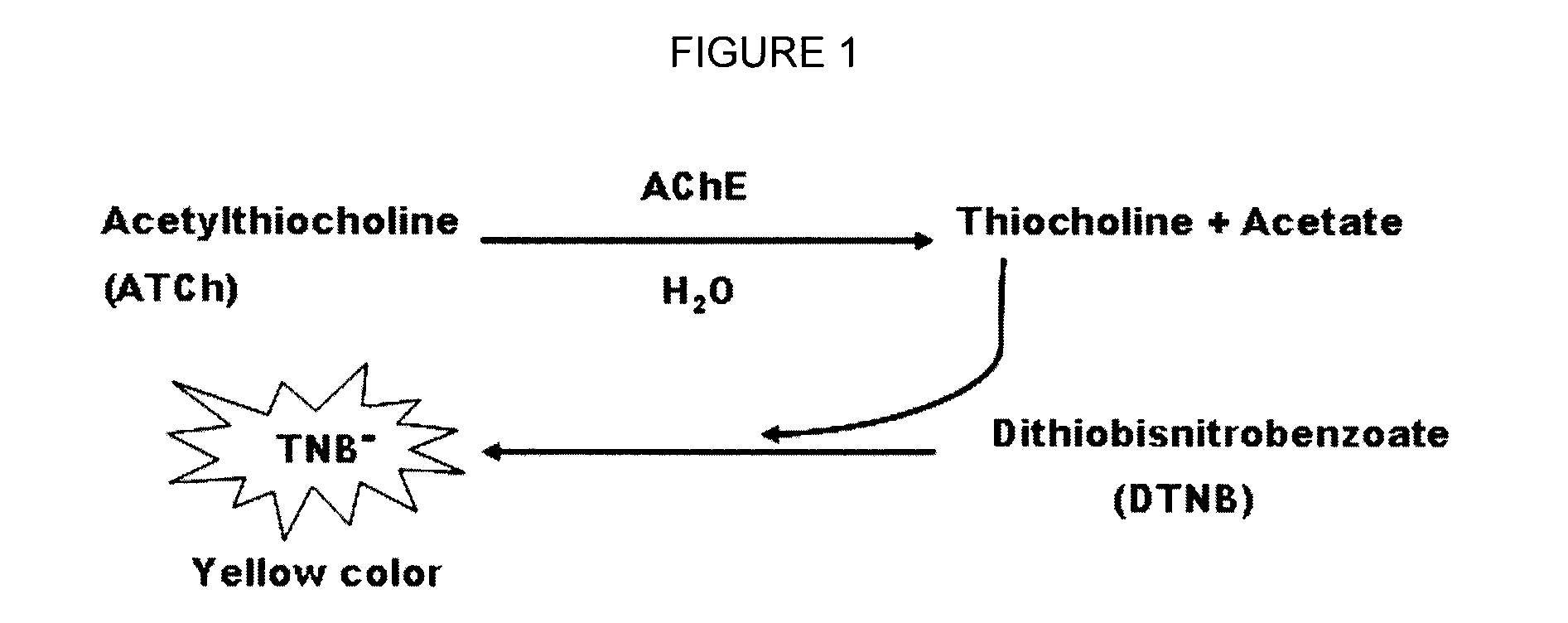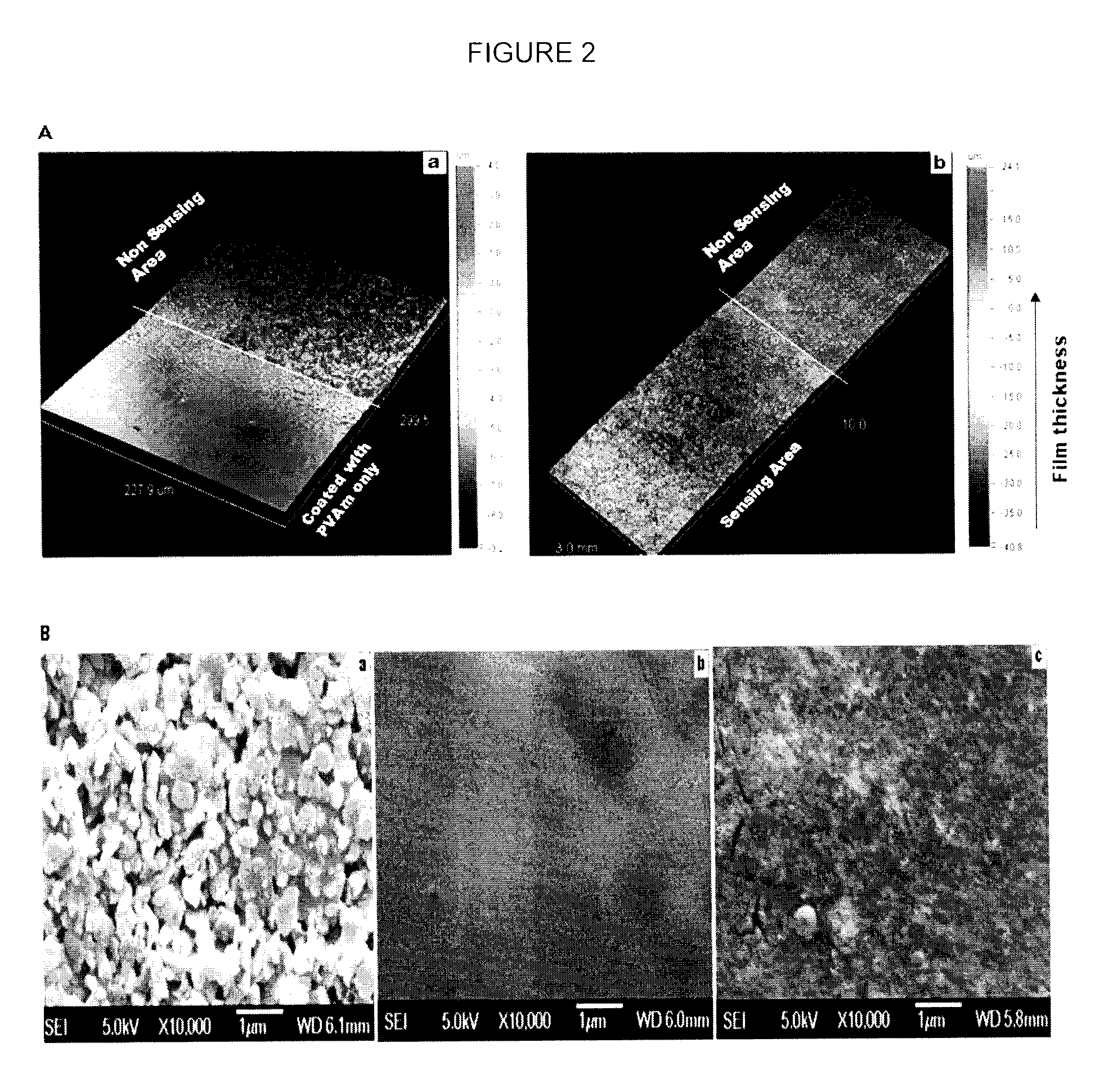Biosensors utilizing ink jet-printed biomolecule compatible sol gel inks and uses thereof
a biosensor and biomolecule technology, applied in the field of biosensors, can solve the problems of aerosol spraying, time-consuming and wasteful, and inability to produce large-scale dip and spin coatings, and achieve the effect of avoiding the need for expensive and sophisticated instrumentation and improving the sensitivity of assays
- Summary
- Abstract
- Description
- Claims
- Application Information
AI Technical Summary
Benefits of technology
Problems solved by technology
Method used
Image
Examples
example 1
Development of Bioactive Paper Sensors Using Piezoelectric Ink Jet Printing of Sol Gel Derived Bioinks
[0177]Chemicals:
[0178]Sodium silicate solution (˜14% NaOH, ˜27% SiO2), tetraethylorthosilicate (TEOS, 98%), Dowex 50WX8-100 ion-exchange resin, acetylcholinesterase (AChE, from electrophorus electricus, EC 3.1.1.7), paraoxon, aflatoxin B1 (AfB1, from aspergillus flavus), 5,5′-dithiobis-(2-nitrobenzoic acid) (DTNB), carboxymethylcellulose sodium salt (CMC), and Triton X-100 were obtained from Sigma-Aldrich. Anhydrous glycerol and acetylthiocholine iodide (ATCh) were purchased from Fluka BioChemika Ultra (UK). Diglyceryl silane (DGS) was synthesized in our lab using by transesterification of TEOS with anhydrous glycerol as described in detail elsewhere.26 Polyvinylamine (PVAm; 1.5 MDa) was obtained from BASF (Mississauga, Canada), as a gift. Mead brand cardboard paper substrate with a white hydrophobic clay coating (Manufactured by Hilroy, Toronto, Canada) was purchased from McMaster ...
example 2
Reagentless Bioactive Paper-Based Lateral Flow Sensor for Detection of Pesticides
[0224]Reagents:
[0225]All chemical from commercial sources were of analytical grade. Sodium silicate solution (˜14% NaOH, ˜27% SiO2), dowex 50WX8-100 ion-exchange resin, acetylcholinesterase (AChE, from electrophorus electricus, EC 3.1.1.7), Triton X-100, the pesticides including both organophosphate (OP) (e.g., paraoxon and malathion), and carbamate (CM) (e.g., carbaryl and bendiocarb) were obtained from Sigma-Aldrich (Oakville, ON, Canada). The indophenyl acetate (IPA) was purchased from Pealtz & Bauer, Inc (USA). Polyvinylamine (PVAm; 1.5 MDa) was obtained from BASF (Mississauga, Canada), as a gift. Anhydrous glycerol was purchased from Fluka BioChemika Ultra (UK). Distilled deionized water was obtained from a Milli-Q Synthesis A10 water purification system.
[0226]Solutions Preparation:
[0227]Stock solutions of the IPA, bendiocarb, carbaryl, paraoxon and malathion were made up daily and were not used fo...
example 3
Development of a Bioactive Lab-on-Paper Sensor for the Detection of E. coli Based on β-glucuronidase Activity
[0267]Chemicals and Solutions:
[0268]β-Glucuronidase (GUS, type VII-A, from E. coli, EC 3.2.1.31), indoxyl-β-D-glucuronide cyclohexylammonium salt (IBDG), 5-bromo-4-chloro-3-indolyl β-D-glucuronide sodium salt (X-Gluc), p-nitrophenyl-β-D-glucuronide (PNPG), sodium silicate solution (˜14% NaOH, ˜27% SiO2), Dowex 50WX8-100 ion-exchange resin, methyltrimethoxysilane (MTMS), polyacrylic acid (PAA, MW˜1.25 MDa), 2,3-dichloro-5,6-dicyanobenzoquainone (DDQ), m-chloroperbenzoic acid (MCPBA), 2-iodoxybenzoic acid (IBX), H2O2, FeCl3. 6H2O, Triton X-100, Tween-20, and B-lysing agent were purchased from Sigma-Aldrich. Polyvinylamine (PVAm; 1.5 MDa) was obtained from BASF (Mississauga, Canada), as a gift. B-PER Direct bacterial protein extraction reagent was obtained from Thermo Scientific. Fe2O3 beads and E. coli polyclonal antibody were purchased from BioClone Inc. and Abcam, respectivel...
PUM
| Property | Measurement | Unit |
|---|---|---|
| pH | aaaaa | aaaaa |
| time | aaaaa | aaaaa |
| temperatures | aaaaa | aaaaa |
Abstract
Description
Claims
Application Information
 Login to View More
Login to View More - R&D
- Intellectual Property
- Life Sciences
- Materials
- Tech Scout
- Unparalleled Data Quality
- Higher Quality Content
- 60% Fewer Hallucinations
Browse by: Latest US Patents, China's latest patents, Technical Efficacy Thesaurus, Application Domain, Technology Topic, Popular Technical Reports.
© 2025 PatSnap. All rights reserved.Legal|Privacy policy|Modern Slavery Act Transparency Statement|Sitemap|About US| Contact US: help@patsnap.com



